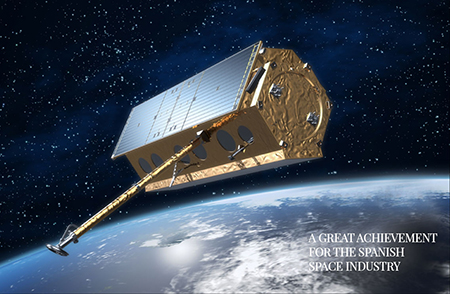
PAZ
Jump to: Mission Objectives, Mission Instrumentation, Mission Parameters, Additional Information
Mission Images:
 |
|
| Image courtesy of HISDESAT | |
Mission Objectives:
The objectives of the PAZ mission are to provide:
- SAR (Synthetic Apeture Radar) images for dual use
- Radio Occultation data suitable to be ingested into numerical weather prediction models (NWP) in near-real time, to contribute to reducing the forecast error
- A SAR data fusion capability for maritime surveillance from space with AIS data services
Laser ranging will help in the calibration of the on-board microwave Precise Orbit Determination system (IGOR GPS receiver).
Mission Parameters:
| Sponsor: | HISDESAT |
| Expected Life: | 5.5 years |
| Primary Applications: | Aid in weather prediction |
| COSPAR ID: | 1802001 |
| SIC Code: | 2501 |
| NORAD SSC Code: | 43215 |
| Launch Date: | Feb. 22, 2018 |
| RRA Size: | |
| RRA Shape: | Hemispherical/Pyramid |
| Reflectors: | 4 |
| Size of Reflector: | 39 mm diameter, 47.41 mm height |
| Orbit: | |
| Orbital period: | 94.85 minutes |
| Inclination: | 97.44 degrees |
| Altitude: | 514km |
| Eccentricity: | 0 |
Additional Information:
Websites:
References:
- K. Bach, H. Kahabka, C. Fernando and J. C. Perez (2018), "The TerraSAR-X / PAZ Constellation: Post-Launch Update," Proceedings of the 12th European Conference on Synthetic Aperture Radar (EUSAR 2018), Aachen, Germany, 2018, pp. 1-3, https://ieeexplore.ieee.org/document/8438110
- N. C. Vazquez, P. C. Revenga, N. G. Martinez, A. L. Pescador, J. M. Cuerda Munoz and J. R. Larranaga-Sudupe (2018), "INTA Calibration Field deployment and management. First experiences after PAZ launch," EProceedings of the 12th European Conference on Synthetic Aperture Radar (EUSAR 2018), Aachen, Germany, 2018, pp. 1-4, https://ieeexplore.ieee.org/document/8438107




